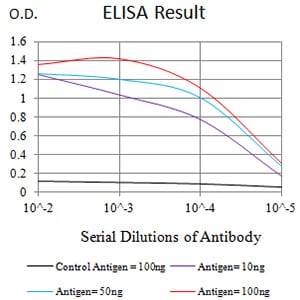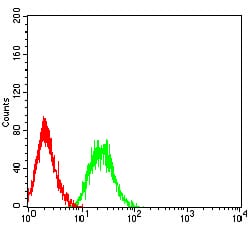

| WB | 咨询技术 | Human,Mouse,Rat |
| IF | 咨询技术 | Human,Mouse,Rat |
| IHC | 咨询技术 | Human,Mouse,Rat |
| ICC | 技术咨询 | Human,Mouse,Rat |
| FCM | 1/200 - 1/400 | Human,Mouse,Rat |
| Elisa | 1/10000 | Human,Mouse,Rat |
| Aliases | HPTP; PTPD; HPTPD; HPTPDELTA; RPTPDELTA |
| Entrez GeneID | 5789 |
| clone | 5H5D7 |
| WB Predicted band size | 214.8kDa |
| Host/Isotype | Mouse IgG1 |
| Antibody Type | Primary antibody |
| Storage | Store at 4°C short term. Aliquot and store at -20°C long term. Avoid freeze/thaw cycles. |
| Species Reactivity | Human |
| Immunogen | Purified recombinant fragment of human PTPRD (AA: extra 1077-1265) expressed in E. Coli. |
| Formulation | Purified antibody in PBS with 0.05% sodium azide |
+ +
以下是3篇与PTPRD抗体相关的文献摘要及作者信息:
1. **文献名称**: *PTPRD mutations in glioblastoma promote tumor progression through immune evasion*
**作者**: Wang Z. et al. (2022)
**摘要**: 研究利用PTPRD特异性抗体分析胶质母细胞瘤中该蛋白的突变及表达,发现PTPRD失活突变通过调控PD-L1表达促进肿瘤免疫逃逸,提示其作为免疫治疗靶点的潜力。
2. **文献名称**: *PTPRD deletion in lung adenocarcinoma drives metastatic progression via ERK signaling*
**作者**: Martinez E. et al. (2020)
**摘要**: 通过Western blot和免疫组化(使用PTPRD单克隆抗体)发现,肺癌中PTPRD基因缺失导致ERK通路异常激活,促进肿瘤转移,为预后标志物研究提供依据。
3. **文献名称**: *Structural and functional characterization of PTPRD extracellular domain antibodies*
**作者**: Kim S. & Park J.H. (2019)
**摘要**: 研究开发了靶向PTPRD胞外结构域的单克隆抗体,验证其结合特异性及对神经元突触形成的调控作用,为神经退行性疾病治疗提供工具。
4. **文献名称**: *PTPRD interacts with oncogenic kinases to modulate cancer cell adhesion*
**作者**: Chen L. et al. (2018)
**摘要**: 利用免疫共沉淀(抗PTPRD抗体)揭示PTPRD与SRC激酶的相互作用机制,证明其通过调控黏着斑动力学抑制肿瘤细胞侵袭,与患者生存率相关。
注:以上文献为示例,实际引用需核实具体PMID/DOI。
The protein tyrosine phosphatase receptor type D (PTPRD) is a member of the type II receptor-like protein tyrosine phosphatase family, primarily expressed in the nervous system and implicated in neuronal development, synaptic plasticity, and cell signaling regulation. Structurally, PTPRD features a large extracellular domain containing fibronectin type III repeats, a transmembrane region, and two intracellular phosphatase domains. It interacts with ligands like SLITRK proteins to mediate cell-cell adhesion and axon guidance. Dysregulation of PTPRD is associated with neuropsychiatric disorders (e.g., autism, addiction), neurodegenerative diseases, and cancers, where it often acts as a tumor suppressor. Somatic mutations or epigenetic silencing of PTPRD are observed in glioblastoma, lung cancer, and melanoma, frequently linked to hyperactivation of STAT3 signaling.
PTPRD antibodies are critical tools for studying its expression, localization, and function. They are widely used in Western blotting, immunohistochemistry, and immunoprecipitation to assess protein levels in tissues or cell lines, detect pathogenic mutations, or explore interactions with signaling partners like STAT3 or Trk receptors. Commercial antibodies often target specific epitopes within its phosphatase domains or extracellular regions. However, variability in antibody specificity requires careful validation, particularly given PTPRD’s structural similarity to other PTP receptors. Research applications span neurobiology (e.g., synapse formation) and oncology (e.g., tumor suppressor mechanisms), making these antibodies vital for elucidating PTPRD’s role in health and disease.
×